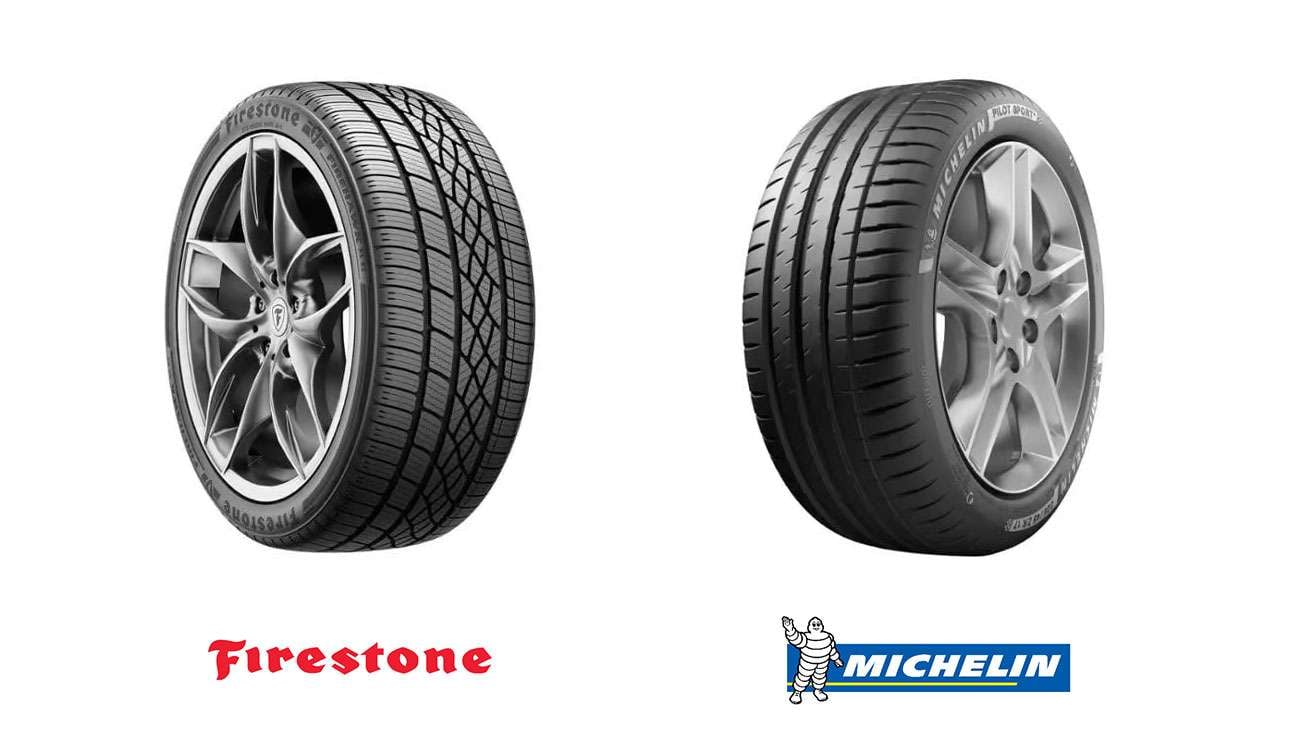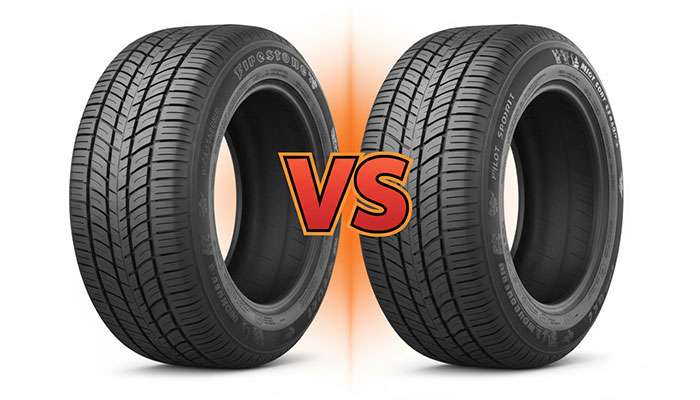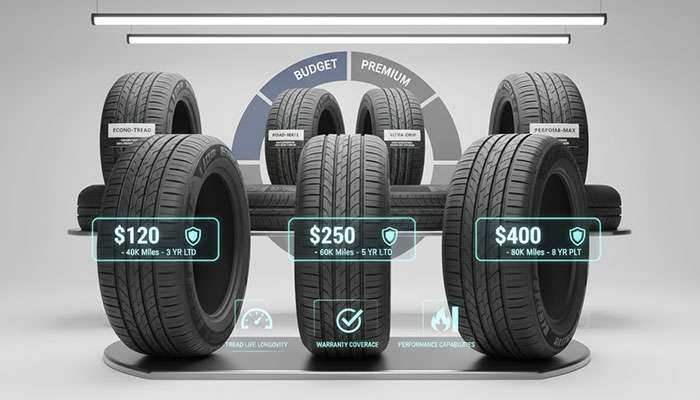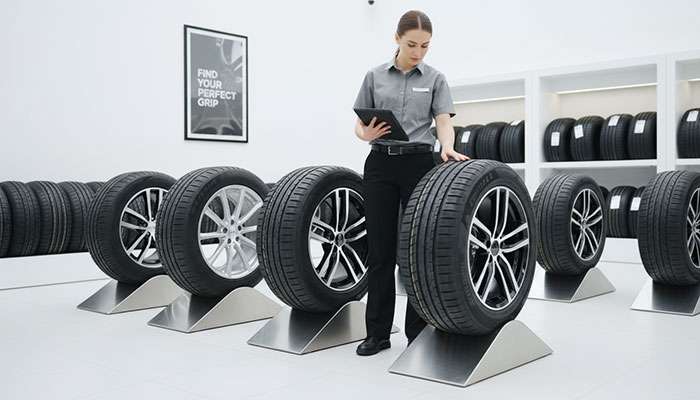
Choosing between Firestone and Michelin tires comes down to understanding what each brand delivers for your specific driving needs and budget. Firestone built its reputation starting in 1900 by developing non-skid treads and partnering with Ford Motor Company. Michelin's story began earlier in 1889, when the Michelin brothers took control of a struggling French rubber factory. Over 130 years, Michelin has focused on materials science innovation to improve safety and performance.
At Performance Plus Tire, we see drivers asking this question daily. Firestone tires deliver reliable performance at prices that won't break the bank, making them popular with everyday drivers. Michelin tires command higher prices but offer superior performance, especially for high-performance and luxury vehicles. The difference shows up in real driving - one customer got an impressive 96,000 miles from their Michelin tires, while another reported dramatic handling improvements after switching from Firestone Destinations to Michelin Defenders.
Your choice depends on what matters most for your driving situation. Firestone provides dependable, budget-friendly options for daily commuting and standard driving conditions. Michelin costs more upfront but delivers better traction in rain, snow, and challenging road conditions. We'll break down exactly what makes each brand different and help you select the right tires for your vehicle, driving style, and budget.

Two tire giants dominate today's market with completely different approaches to serving drivers worldwide.
Harvey Firestone launched his tire company in Akron, Ohio in 1900, building relationships that shaped the automotive industry. The brand earned its reputation by partnering with Ford Motor Company and pioneering the non-skid tread in 1909. Firestone's dominance at racing events like the Indianapolis 500 established it as America's trusted tire brand.
Since 1988, Bridgestone has owned Firestone after acquiring the company for $2.60 billion. This acquisition instantly boosted Bridgestone's global market share from 10% to 17%, making it the world's second-largest tire manufacturer. Firestone continues manufacturing in Illinois, Tennessee, and other American facilities while maintaining its domestic brand identity.
The Michelin brothers founded their company in Clermont-Ferrand, France in 1889 by taking over a struggling rubber factory. For over 130 years, Michelin has built its reputation through technological breakthroughs and innovation. The company invests nearly €1.2 billion annually in research and development, holding over 12,000 active patents worldwide.
Michelin ranks as the world's most valuable tire brand, with brand value reaching $8.8 billion according to Brand Finance reports. The company maintains its premium market position through consistent quality, earning near-perfect familiarity and recommendation scores across global markets.
Price points clearly separate these brands' target customers. Firestone tires typically cost $110 to $150 each, appealing to budget-conscious drivers seeking reliable performance. Michelin commands premium pricing from $140 to over $200 per tire, targeting customers who prioritize advanced technology and longer tread life.
The choice comes down to driving priorities and budget. Firestone serves everyday drivers who need dependable tires at accessible prices. Michelin targets premium buyers who demand advanced safety features, extended mileage, and consistent performance across all road conditions.

When it comes to performance, testing data reveals clear differences between these tire brands across critical driving metrics.
Longevity creates the biggest performance gap between these brands. Firestone tires typically deliver 60,000 to 65,000 miles of service, while Michelin tires consistently reach 80,000+ miles. Warranty coverage reflects this difference - Firestone Destination A/T2 provides 55,000-mile protection compared to Michelin Defender LTX Platinum's 70,000-mile coverage. Real-world data supports these numbers, with one driver's Firestones wearing out at 55,000 miles while their Michelins continued performing past 85,000 miles.
Both brands perform adequately on dry roads, but challenging conditions separate their capabilities. Firestone employs Snow Traction Claw technology for enhanced grip in light snow conditions. Michelin's EverGrip technology delivers superior all-condition traction. Testing shows Michelin Defenders maintain better control on wet surfaces, providing more confident turning and shorter stopping distances.
Noise control approaches differ significantly between brands. Firestone uses 5-Pitch Tread Design to reduce initial road noise. However, drivers report increasing noise levels as these tires age. Michelin incorporates advanced acoustic technology that maintains quieter operation throughout the tire's life, even at highway speeds. Owners consistently praise Michelin's ability to minimize road noise on rough pavement.
Both manufacturers design their tires for improved fuel economy. Department of Energy research indicates tire rolling resistance affects 4-11% of total fuel consumption. A 10% reduction in rolling resistance typically yields about 1% fuel economy improvement. Drivers generally experience approximately 0.5 MPG better fuel economy with Michelin tires.
Michelin holds clear advantages in severe winter conditions. Michelin's severe snow tires carry the Three Peak Mountain Snowflake rating, indicating performance exceeding standard requirements. Firestone offers weather-ready tires that meet basic winter needs but lacks this advanced certification. Drivers navigating regular snow conditions benefit significantly from Michelin's superior winter traction capabilities.
Construction quality affects durability and protection levels. While both brands offer adequate sidewall strength for everyday driving, Michelin designs stronger sidewall construction into its tire models. This enhanced protection resists damage from curbs and road hazards better than Firestone's standard construction. Professional drivers who regularly encounter challenging road conditions appreciate this additional durability.

Understanding true tire costs means looking beyond the initial purchase price to calculate long-term ownership expenses.
Upfront costs separate these brands significantly. Firestone tires fall within the $80-$150 range per tire, making them accessible for budget-conscious consumers. A complete set of four Firestone tires typically costs $320-$600. Michelin's premium positioning demands $120-$250 per tire, with full sets ranging from $480-$1,000. This price difference reflects fundamental differences in manufacturing standards, materials quality, and performance capabilities.
Long-term value calculations shift the financial equation. When you divide tire price by expected mileage, Michelin's extended lifespan creates compelling value. A Michelin tire at $200 lasting 80,000 miles costs approximately $0.0025 per mile. A Firestone tire at $120 delivering 60,000 miles costs about $0.0020 per mile. However, this calculation doesn't account for fuel economy improvements and potential safety benefits from better wet weather performance.
Replacement timing affects total vehicle maintenance budgets. With Firestone tires lasting approximately 60,000-65,000 miles, you'll face tire replacement more frequently than with Michelin's 80,000+ mile performance. Over 240,000 miles of driving, you'd replace Firestone tires four times compared to three replacements with Michelin. This frequency difference creates additional service costs and time investments for tire shopping and installation.
Small fuel efficiency improvements compound over thousands of miles. That 0.5 MPG advantage with Michelin tires generates meaningful savings for high-mileage drivers. At 15,000 miles per year with 25 MPG average and $3.50 per gallon fuel costs, the improved efficiency saves approximately $42 annually. Over the tire's 80,000-mile lifespan, this equals roughly $224 in fuel savings, helping offset the higher initial investment.
Manufacturer warranties provide different protection levels. Michelin's mileage warranties typically extend to 70,000 miles, demonstrating confidence in product durability. Firestone's warranties cluster around 55,000-60,000 miles. Road hazard protection costs and coverage terms vary by retailer. These warranty differences matter most when unexpected tire damage occurs within coverage periods, potentially saving hundreds in premature replacement costs.

Matching tire performance to your specific driving requirements ensures you get the best value and safety from your investment.
Drivers logging under 15,000 miles annually on predictable routes find excellent value in Firestone tires. These tires deliver reliable performance for highway commuting and city driving at prices that maximize budget flexibility. The typical 60,000-mile service life extends across four years at this usage rate, providing adequate longevity without premium pricing. Firestone's adequate wet weather performance handles occasional rain without requiring advanced traction technology.
Heavy drivers accumulating 20,000+ miles annually should seriously consider Michelin's extended tread life benefits. At this usage rate, you'd reach Firestone's 60,000-mile limit in three years compared to four years with Michelin's 80,000-mile performance. The reduced replacement frequency saves service time and installation costs. Michelin's superior fuel efficiency becomes more significant at higher annual mileage, generating larger cumulative savings over the tire's life.
Your local weather patterns should influence tire selection strongly. Drivers in consistently dry climates like Arizona or Southern California find Firestone tires meet their needs effectively. Both brands perform similarly on dry pavement, making premium pricing less justified. However, residents of rainy regions like the Pacific Northwest or areas with regular winter weather benefit substantially from Michelin's superior wet and snow traction. The safety advantages of better grip during challenging conditions justify the investment where adverse weather occurs frequently.
High-performance and luxury vehicle owners typically benefit from Michelin's advanced technology and handling characteristics. These vehicles demand tires that maintain stability during aggressive cornering and deliver consistent performance across speed ranges. Michelin's engineering matches the capabilities of premium vehicles better than Firestone's standard performance focus. The quieter ride quality also complements luxury vehicle expectations for refined driving experiences.
Immediate budget limitations may necessitate choosing Firestone despite Michelin's long-term value advantages. When replacing all four tires creates financial stress, Firestone's lower entry price helps maintain vehicle safety without excessive short-term expense. You can always upgrade to Michelin tires during your next replacement cycle once financial circumstances improve. Some retailers offer financing options that make Michelin's higher upfront costs more manageable through monthly payments.
Customer feedback consistently highlights each brand's strengths within their market segments. One driver reported switching from Firestone Destination tires to Michelin Defenders and experiencing "dramatically better handling" with "excellent traction in rain." Another owner praised their Michelin tires for reaching 96,000 miles while maintaining reliable performance. Conversely, budget-conscious drivers appreciate Firestone's dependability for everyday driving without breaking the bank. These real experiences validate both brands' value propositions within their intended customer segments.
Shop for Firestone tires or Michelin tires at Performance Plus Tire with competitive pricing and available financing options.
Here's a side-by-side breakdown of the key differences between these two tire brands to help you make the right choice for your vehicle:
| Feature | Firestone | Michelin |
|---|---|---|
| Founded | 1900 (Akron, Ohio) | 1889 (France) |
| Price Range (per tire) | $80-$150 | $120-$250 |
| Warranty Coverage | 55,000-60,000 miles | 70,000 miles |
| Typical Tread Life | 60,000-65,000 miles | 80,000+ miles |
| Wet/Snow Technology | Snow Traction Claw | EverGrip Technology |
| Noise Reduction | 5-Pitch Tread Design | Advanced Acoustic Technology |
| Road Noise Performance | Increases with age | Maintains quieter performance |
| Wet Weather Handling | Adequate performance | Superior grip and control |
| Target Market | Budget-conscious consumers | Premium/luxury vehicle owners |
| Real-World MPG Impact | Base performance | ~0.5 MPG better fuel economy |
| Manufacturing Focus | Affordability and reliability | Innovation and premium performance |
| Current Market Position | Part of Bridgestone (since 1988) | World's most valuable tire brand |
This comparison shows exactly where each brand excels. Firestone delivers solid, dependable performance at budget-friendly prices, while Michelin focuses on premium technology and longer-lasting performance. The choice comes down to whether you prioritize immediate savings or long-term value and performance benefits.
When it comes to choosing between Firestone and Michelin tires, the decision comes down to matching the right tire to your specific needs and budget. Michelin consistently delivers superior performance in tread life, wet weather handling, and noise reduction. These tires typically reach 80,000+ miles compared to Firestone's 60,000-65,000 miles, which helps justify their higher price range of $120-$250 per tire. Firestone remains an excellent choice for drivers seeking reliable performance at accessible prices of $80-$150 per tire.
The performance differences show up clearly on the road. Michelin tires provide superior handling confidence, especially during wet weather and cornering situations. They stay quieter throughout their lifespan, while Firestone tires tend to develop more road noise as they age. Firestone delivers adequate performance for daily driving, but Michelin's EverGrip technology and acoustic innovations offer noticeable safety and comfort improvements.
Consider the long-term value equation carefully. Michelin's extended tread life and potential 0.5 MPG fuel economy improvement can deliver better cost per mile despite the higher initial investment. Firestone makes sense for drivers prioritizing immediate savings or shorter vehicle ownership periods.
Your driving habits determine the best choice. Choose Michelin if you frequently drive in challenging weather conditions, value a quieter ride, or plan long-term vehicle ownership. Select Firestone if you have budget constraints or less demanding driving requirements. At Performance Plus Tire, we carry both Firestone tires and Michelin tires to help you compare current pricing, warranties, and models that match your vehicle and driving style.
Both brands offer solid options within their market segments. The key is understanding which tire best serves your driving priorities and financial situation. Our expert team can guide you through the selection process to ensure you get the perfect tires for your needs.
When choosing between Firestone and Michelin tires, understanding their distinct value propositions helps you make the right decision for your driving needs and budget.
• Michelin delivers superior longevity: Michelin tires typically last 80,000+ miles compared to Firestone's 60,000-65,000 miles, offering better long-term value despite higher upfront costs.
• Price reflects performance positioning: Firestone targets budget-conscious drivers at $80-$150 per tire, while Michelin commands premium pricing of $120-$250 for advanced technology and performance.
• Wet weather handling favors Michelin: Real-world testing shows Michelin's EverGrip technology provides superior traction and control in rain and snow compared to Firestone's adequate performance.
• Noise levels differ significantly over time: Michelin maintains quieter operation throughout its lifespan, while Firestone tires develop increasing road noise as they age.
• Your driving habits determine the best choice: Choose Michelin for challenging weather conditions, long-term ownership, and premium performance; select Firestone for reliable everyday driving on a tighter budget.
The decision ultimately balances immediate affordability against long-term performance benefits, with both brands offering solid options within their respective market segments.
Firestone tires offer solid performance for daily driving at a more affordable price range of $80-$150 per tire. Michelin tires, priced between $120-$250 per tire, provide superior longevity, better grip in various weather conditions, and smoother rides, justifying their higher cost with premium performance.
Michelin tires typically last 80,000+ miles and come with warranties up to 70,000 miles. Firestone tires generally last 60,000-65,000 miles and offer warranties around 55,000-60,000 miles. Michelin's longer tread life and more extensive warranty coverage reflect their confidence in product durability.
Michelin tires demonstrate superior performance in wet conditions, offering better traction and control during rainy weather and cornering. Firestone tires provide adequate performance in wet conditions but may not match Michelin's level of grip and handling confidence.
Michelin tires generally maintain quieter operation throughout their lifespan due to advanced acoustic technology. Firestone tires, while initially quiet, tend to develop increased road noise as they age, particularly noticeable on rougher road surfaces.
Michelin tires often provide a slight edge in fuel efficiency, with some drivers reporting approximately 0.5 MPG better fuel economy compared to Firestone tires. This difference, while small, can contribute to long-term savings, especially for high-mileage drivers.